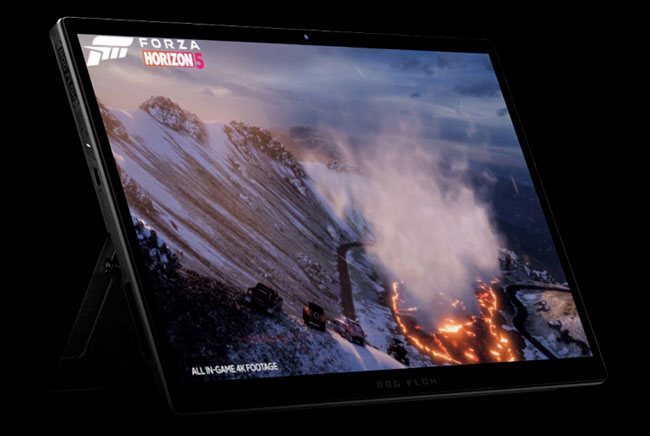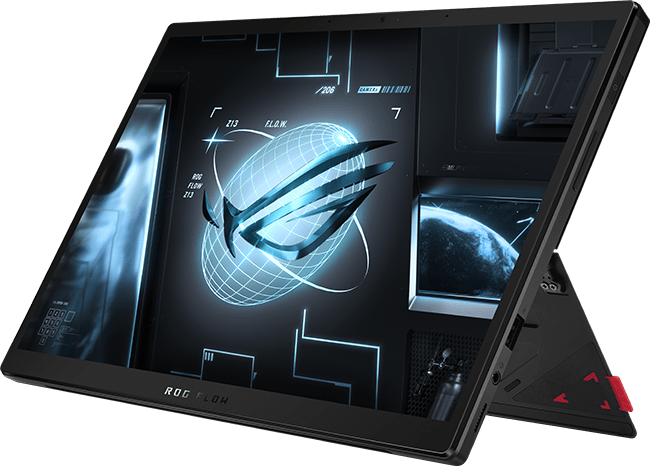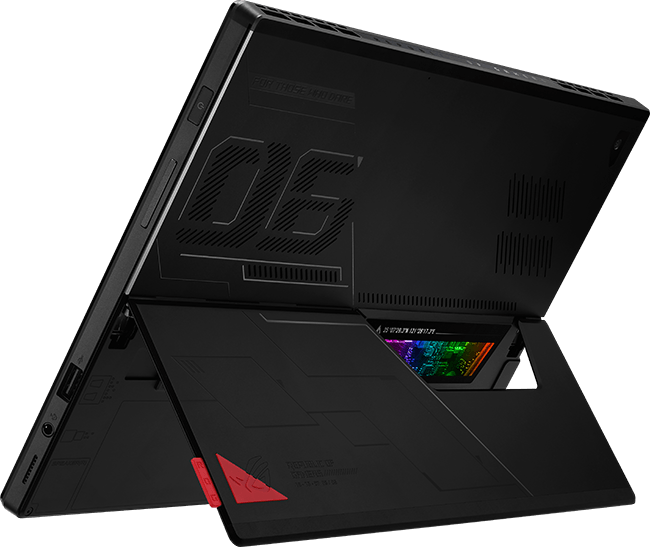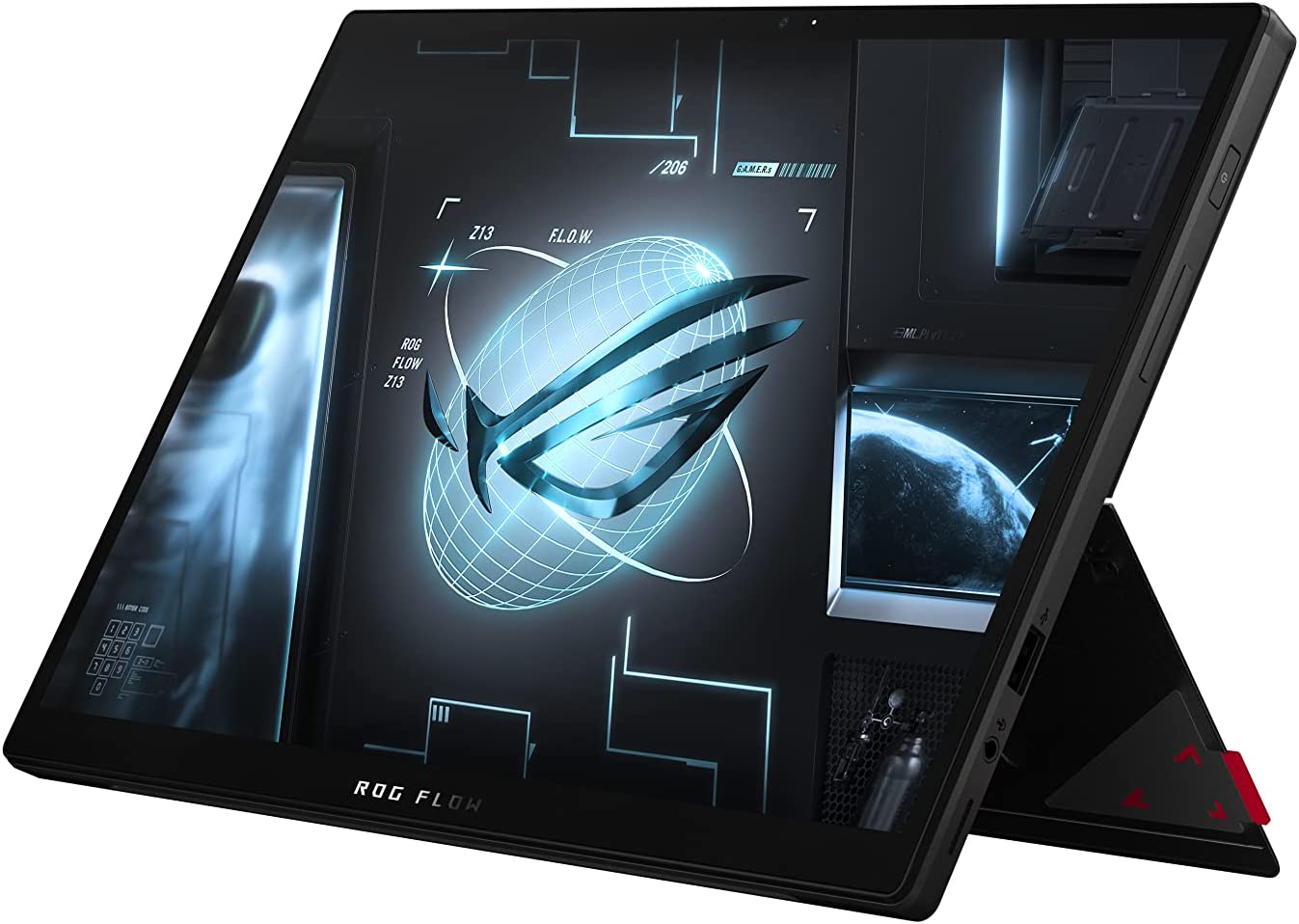NOTE: This review is based on an ASUS ROG Flow Z13 GZ301 FLOW-Z13-GZ301ZE-LC175W model gaming tablet provided by ASUS, containing a 12th Gen Intel Core i9 12900H Processor 2.5 GHz, NVIDIA® GeForce RTX™ 3050 Ti Laptop GPU, 1 TB SSD storage and 8GB*2 LPDDR5 on board, 16 GB dual channel memory.
ASUS kicked off 2022 with a bang at CES, promising a new line of revolutionary gaming devices under their Republic of Gamers line that aimed to elevate the portable PC gaming experience for gamers everywhere. This meant a new Strix SCAR laptop, the dual-screened Zephyrus Duo 16, and the world’s first ‘folding laptop’, the Zenbook 17 Fold OLED.
One of the devices that perhaps turned the most heads among certain tech enthusiasts however is the ROG Flow Z13 gaming tablet. Promising the power of a high-end gaming laptop within the form factor of a tablet, the ROG Flow Z13 ambitiously tries to bring a triple-A laptop pedigree to what is ostensibly a mobile device. Essentially, it’s bringing two different technical worlds together for the ultimate portable gaming experience, at least in concept.
What’s most surprising about this device is how much it succeeds to boot! The ROG Flow Z13 tablet is one seriously impressive piece of tech, boasting a top-tier GPU and processor, and a thin, yet sturdy form factor that makes it truly feel like a laptop and tablet in one machine. Hell, it’s even capable of ray tracing, which was previously unheard of for a gaming tablet! On top of that, its Microsoft Surface-esque detachable keyboard makes it even more portable than most dedicated laptops. This allows the device to blend seamlessly with gaming services like Microsoft’s PC Game Pass and its touch-friendly input options, thus allowing you plenty of flexibility in terms of how you approach your games. This flexibility is especially important when you consider that the ROG Flow Z13 only has one USB port on it.

Which brings me to the inevitable question of how such a device may or may not be compromised through its mission to be ASUS’ best unity of laptop and tablet. To its credit, the ROG Flow Z13 actually minimizes compromise to a shocking degree, but obviously, it doesn’t completely eliminate it. That aforementioned lone USB port is going to be a problem for streamers in particular, who like to plug in a lot of USB devices for their broadcasts. On top of that, while the ROG Flow Z13 is still a damn good gaming tablet, it does function a little better when treated as a laptop on a desk, where its shaky battery life and somewhat heavy weight are not so much of a nuisance.
Finally, the ROG Flow Z13 is, unsurprisingly, fairly pricey. It could potentially set you back upwards of $3,000 CAN at worst! It’s admittedly possible to find better GPU’s and better batteries within certain dedicated gaming laptops too. Don’t misunderstand me though; If you don’t mind the handful of caveats or its price, the ROG Flow Z13 tablet nonetheless remains one of 2022’s coolest and most exciting new gaming devices, especially when it confidently leaves competitors like the Microsoft Surface line completely in the dust from a technical standpoint.
The build quality of the ROG Flow Z13 is immediately striking. This is a very carefully thought-out device that feels easy to transport without feeling easily breakable. The power switch is tucked tightly into the side, for example, so you won’t have to worry about it accidentally turning on when it’s in a transport bag. Plus, even with the detachable keyboard folded into it, the ROG Flow Z13 feels barely thicker than your run-of-the-mill tablet, essentially carrying the width of, say, a decent-sized picture book. It’s obviously a bit heavier than, say, an iPad, and carrying it under your arm may feel a tad uncomfortable if you do it for extended periods of time, but as long as you have a good case to transport it in, that’s not something you’ll truly need to worry about.
The keyboard impressively doesn’t add much width to the device either. It’s not noticeably rigid, instead having an upper end that’s able to freely fold in like a tablet case, for improved ergonomic efficiency. Even so, the keyboard still feels secure, simply coming off with a bit of a tug. The quality of the keys is generally pretty good as well. They’re comfortable, not hard on your wrists, and even typing for extended periods of time doesn’t appear to strain your fingers, especially thanks to a reliable stand built into the back of the tablet. I tested this by typing several written reviews on the ROG Flow Z13, and I can happily report that I never felt even a little bit uncomfortable doing so. That’s great news for people that want the option to take their ROG Flow Z13 experience beyond gaming, especially when the keyboard’s keys aren’t too noisy, with only the space bar having a bit more of a negligible ‘clack’ to it.
“This is a very carefully thought-out device that feels easy to transport without feeling easily breakable.”
Again, the worst thing one can say about the sleek, sexy design of the ROG Flow Z13 is that it only has one USB port, and that can indeed be an issue for gamers that use a lot of USB peripherals. A good wireless/bluetooth mouse is a must with this device, considering that its built-in trackpad is competent, but obviously not up to scratch for games that require a lot of quick mouse movement. Likewise, streamers may be forced to rely on the built-in webcam for face capture, though to this device’s credit, it’s not a bad camera at all, even packing in HDR features! The drawback here is that the built-in front and rear cameras are naturally not quite up to the standards of professional peripheral webcams, with their resolution notably topping out at 720p. Still, you could do a lot worse than this, especially when the ROG Flow Z13’s cameras are well-secured and not prone to damage.
The real surprise here is the device’s audio capabilities. Again, streamers are better off using a dedicated microphone for audio input, but the tablet’s built-in Dolby Atmos and hi-res audio capabilities are surprisingly excellent when it comes to audio output. The ROG Flow Z13 effortlessly creates surround sound even from its built-in speakers, so you won’t even need headphones to get a surprising amount of audio muscle from your gaming experiences! I was also impressed to see how well the built-in mic isolates sound, even when you’re using it in a crowd of people and other noises. It’s still not a perfect substitute for a dedicated peripheral microphone though, with the device’s dual speakers cleaning up a surprising amount of unwanted audio, but still not perfectly replicating the same clarity that an actual streamer-oriented microphone would.
The astonishing processing power behind the ROG Flow Z13 is undeniably impressive. Its fairly powerful Intel i9 12900H processor can run many games at surprisingly high framerates, so long as players don’t mind taking occasional hits in resolution. Hitting 60fps targets in most high-end games isn’t too difficult on at least Medium settings with the ROG Flow Z13, sometimes even stretching to High without much strain, depending on the game in question. Anything on Ultra will probably knock you down to 30fps though, if not less.
Through a series of built-in fan settings, you can also easily optimize the tablet’s capabilities to either conserve power, or deliver improved performance with superior brightness. You can make the fan completely silent, for example, which works as advertised, so long as you don’t mind having to deal with a darkened screen and diminished framerates in that case. The moderate-minded Performance setting meanwhile is generally pretty solid for the majority of single-player games or strategy-oriented competitive games. Pushing the device with its Turbo setting is where the ROG Flow Z13 really impresses though, delivering surprisingly strong performance and brightness even while playing intensive games like, say, Rocket League, or the various Call of Duty titles, all while the fan keeps itself surprisingly under control. It’s obviously not quiet when you crank the performance, but you’d be surprised at how comfortably the tablet’s fan runs, even on its Turbo setting.

That being said, it’s inevitable that pushing the tablet to Turbo settings will absolutely shred through its battery. It’s best to only use the high-end Turbo setting when the tablet is plugged into its power supply, because otherwise, you’ll be lucky to get an hour of play before the device dies. The tablet’s power-saving options can push its battery life to just under three hours at best, but that’s still not great for extended play sessions, especially when you’ll inevitably be taking a hit in responsiveness on diminished fan settings.
This is the primary reason why the ROG Flow Z13 feels more useful as a laptop than a tablet. It’s very impressive to see how well it plays and performs with even high-end PC games while fully detached, but the resulting compromises to the battery make fully portable play a lacklustre option without the power supply handy. Even using video streaming services like Netflix or Disney+ doesn’t appear to offer many hours of fully detached battery life, which is a bit of a let-down for a device that wants to give you the convenience of a tablet with the power of a gaming laptop.
The NVIDIA GeForce RTX 3050 TI GPU that’s sported under the hood of the ROG Flow Z13 is definitely nothing to sneeze at. This is a true gaming laptop-worthy GPU that absolutely trounces any other gaming tablet’s technical potential. This ray tracing-enabled GPU can push your video settings to extraordinary heights (at least, by tablet standards) in many instances, though this would have been more exciting if the device’s battery and performance weren’t so vulnerable. Still, if the tablet is plugged in, running visually intensive games like Cyberpunk 2077 or Elden Ring on higher video settings works a lot better than you would think, if you don’t mind their performance capping at 30fps.
Because the ROG Flow Z13 is still aspiring to fit into the tablet space however, you can imagine that you won’t be topping out settings on higher-end triple-A games. This device can run cross-gen games at Medium to High settings without much difficulty at least, as proven by my personal benchmark and play tests for assorted games like LEGO Star Wars: The Skywalker Saga, Tiny Tina’s Wonderlands, Gears Tactics, Resident Evil Village, Halo: The Master Chief Collection, Life is Strange: True Colors, Marvel’s Guardians of the Galaxy, and the aforementioned Elden Ring. Among those titles, only Tiny Tina’s Wonderlands felt a bit strained on High settings, with the rest managing a reliable 60fps performance clip at 1080p resolution. Even if you sometimes have to drop down to 720p for best results however, the tablet-sized screen doesn’t really make this too apparent; You’re still getting a rather gorgeous, well-performing gaming experience with these titles.
“Still, if the tablet is plugged in, running visually intensive games like Cyberpunk 2077 or Elden Ring on higher video settings works a lot better than you would think, if you don’t mind their performance capping at 30fps.”
It’s when you start getting into dedicated current-gen games with beefier system requirements that the ROG Flow Z13 sometimes finds its graphical capabilities stretched too far, even with a fairly strong GPU. For this, I tested benchmarks for Ghostwire: Tokyo, Gotham Knights and A Plague Tale: Requiem, and while Ghostwire: Tokyo made it to High settings without much fuss, Gotham Knights definitely suffered performance hits above Medium settings. It was A Plague Tale: Requiem that really proved tough to run though; I had to drop the settings all the way down to Low in order to get consistent 30fps performance there, something that seems a bit odd, considering the surprisingly solid processor/GPU combo we’re getting in the device.
It’s worth noting however that these are all single-player games with an emphasis on atmosphere over fast-paced gameplay. Like I said, the ROG Flow Z13 seems to fare a bit better with exciting games that place action over visuals. Even on the single-player end, I found that a heavily action-oriented title like Devil May Cry 5 could push itself pretty far on the hardware, hitting 60fps performance pretty easily, even at the cost of playing in 720p. Thus, competitive gamers who want to make every frame count will probably still find themselves pleasantly surprised with just how much horsepower they can squeeze out of this gaming tablet. If nothing else, the emphasis on performance over pixels proves that ASUS probably has their priorities in the right place with this device.
If you approach the ROG Flow Z13 as a gaming laptop first and a tablet second, it’s a very solid, highly portable device that presents one of the most compact, yet well-built PC gaming options on the market at this point. The technology necessary to fully realize the device’s tablet ambitions still doesn’t feel quite there yet, especially given how quickly the battery drains when you actually try to make use of beefier resolutions and performance settings, but as long as your power supply is handy, you’re still getting a pretty impressive machine for the admittedly considerable cost. Compared to ASUS’ previous gaming tablet line, the ROG Flow X13 models, you’re also seeing a significant improvement in specs and functionality with the ROG Flow Z13 models, one that finally starts to see the dream of a unified gaming laptop/tablet experience begin to take shape in earnest.
The cost, however, can be another barrier. As cool as it is, the ROG Flow Z13 is not cheap, and you can likely find more cost-effective laptop options in particular for less than its staggering $2,500-$3,000 CAN price range, even among ASUS’ own Zephyrus laptops. That puts the ROG Flow Z13 in the awkward position of functioning best as a gaming laptop, while commanding the price of the most ambitious gaming tablet on the market. It can be a little tough to justify that if you’re very value-conscious, and aren’t attracted to the idea of a hybrid gaming device that feels undeniably cutting-edge, but still can’t always keep up when pitted against more dedicated gaming laptops especially.

Where the ROG Flow Z13 feels like it best explores its potential is through Game Pass, and cloud gaming services like NVIDIA’s own GeForce NOW. It’s internet-ready for even high-end gaming routers, and if you don’t mind plugging it in, streaming games to the tablet display is seamless and beautiful, without as much of a noticeable cost to performance on higher settings. It’s not ideal, and it still falls shy of a truly portable, tablet-esque gaming laptop without compromise, but even playing natively through mainline PC gaming platforms like Steam and the Epic Games Store, you’re getting a surprisingly impressive gaming device that puts a lot of legit chops behind a very small package.

